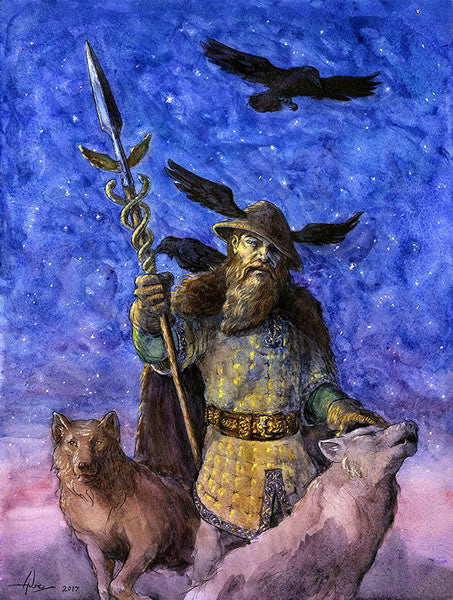Odin As Mercury
by Jodie Forrest
all images by Aubrey Brown
This article first appeared in The Mountain Astrologer magazine. Reprinted with permission.
Do you give astrological readings? What planet are you most likely to hurry through if time is pressing? Mercury, most likely. And little wonder: the Mercury-Hermes of classical Greek and Roman mythology could be passed over as a message-carrying youth, a glib and quicksilver lightweight. Mercury is a quick-witted deity of logic and order–lord of the logical left brain, as it were.
Certainly that can be an accurate description astrologically. Accurate, but incomplete. Even the classical world also saw Mercury as a psychopomp–a guide of souls to the Underworld–and as the ruler of crossroads and other transitional states. The planet Mercury rules how we perceive and communicate–yet the left brain isn’t our only perceptive mode, and linear reasoning or the body’s five senses aren’t the only methods of apprehending reality. What the classical world more or less neglects in Mercury–the path of the right brain, the truths of the psychic or the shaman–is preserved in the Northern European tradition’s god, Odin.
 Odin is the chief Norse-Teutonic god, not merely that pantheon’s errand boy, and no callow lad. He rules war, magic, poetry and the dead. Those multiple rulerships indicate a complex archetype with multiple guises. Usually described as a tall vigorous man somewhat past middle age, who often wore a cloak and a wide-brimmed hat to hide his one remaining eye, Odin was said to be a master of disguises, and fond of lurking unnoticed among mortals. Perhaps he’s wandered through your readings more than once. Your consulting room is his territory, after all. This nomadic seeker of knowledge is the god of seers, soothsayers, sorcerers and berserkers. If he hasn’t paid you a personal visit, he may have sent his raven-familiars, Thought and Memory. Each day they fly through the nine worlds of Norse cosmology and tell Odin what they see. Play an instrument? Use parables in your astrological interpretations? Then meet your elusive patron: Odin rules poets, bards and storytellers.
Odin is the chief Norse-Teutonic god, not merely that pantheon’s errand boy, and no callow lad. He rules war, magic, poetry and the dead. Those multiple rulerships indicate a complex archetype with multiple guises. Usually described as a tall vigorous man somewhat past middle age, who often wore a cloak and a wide-brimmed hat to hide his one remaining eye, Odin was said to be a master of disguises, and fond of lurking unnoticed among mortals. Perhaps he’s wandered through your readings more than once. Your consulting room is his territory, after all. This nomadic seeker of knowledge is the god of seers, soothsayers, sorcerers and berserkers. If he hasn’t paid you a personal visit, he may have sent his raven-familiars, Thought and Memory. Each day they fly through the nine worlds of Norse cosmology and tell Odin what they see. Play an instrument? Use parables in your astrological interpretations? Then meet your elusive patron: Odin rules poets, bards and storytellers.
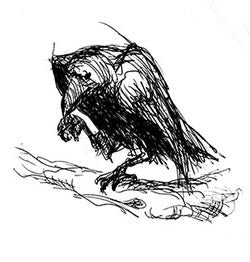 The inspiration of the wordsmith who induces a kind of trance in his or her listeners; the altered and visionary state of the occultist; the ecstatic frenzy of the warrior: what do these roles share? Their common ground is their inspiration by Odin as a way of non-linear knowing, learning or communicating in non-ordinary states of consciousness, along with the rational thought processes attributed to classical Mercury. Remember that Odin has two ravens, Thought and Memory. Left brain and right brain. Reason and intuition. Telepathy and clairvoyance. Alertness to the present moment, with full knowledge of the past. In a verse from the Elder Edda, a compendium of ancient Norse poetry, Odin states:
The inspiration of the wordsmith who induces a kind of trance in his or her listeners; the altered and visionary state of the occultist; the ecstatic frenzy of the warrior: what do these roles share? Their common ground is their inspiration by Odin as a way of non-linear knowing, learning or communicating in non-ordinary states of consciousness, along with the rational thought processes attributed to classical Mercury. Remember that Odin has two ravens, Thought and Memory. Left brain and right brain. Reason and intuition. Telepathy and clairvoyance. Alertness to the present moment, with full knowledge of the past. In a verse from the Elder Edda, a compendium of ancient Norse poetry, Odin states:
Thought and Memory
every day fly over the earth.
I fear for Thought,
that he may not return
Yet still more I fear
the loss of Memory.
The god needs and uses both ravens–does our technological and left-brain-oriented modern world do as much today? Why might it be important to explore the concept of Odin as Mercury? Aren’t the planet’s classical definitions enough? No, not always, and the reasons why may become rather personal…
Visualize a sphere the approximate shape of a hard-boiled egg with its narrow end pointing up. Let the sphere represent the totality of your awareness, both conscious and unconscious. Now insert an imaginary plane through the sphere just above the hard-boiled egg’s yolk. The area above that plane represents your conscious mind, home of the ego complex that generally occupies the driver’s seat. Beneath that plane lies the realm of the unconscious.
Jodie Forrest: Odin as Mercury
 The Norse god Odin's traits compared and contrasted to classical astrology's Mercury. The chief Norse deity, god of war, magic, poetry and the dead, Odin as Mercury can symbolize a non-linear, intuitive and shamanistic method of perception.
The Norse god Odin's traits compared and contrasted to classical astrology's Mercury. The chief Norse deity, god of war, magic, poetry and the dead, Odin as Mercury can symbolize a non-linear, intuitive and shamanistic method of perception.Divisions become arbitrary here, but suppose that another plane runs across the sphere through the center of the egg yolk itself. Above that second plane and below the first one would lie your personal unconscious, the part most affected by your individual life’s history and the influence of your family of origin. Beneath that second plane is the collective unconscious, home of the archetypes common to all cultures who’ve walked the earth. You know, intuitively, what a poet is, how shamans behave, and what priestesses are. So did the Magdalenian civilizations who painted the cavern walls of prehistoric France and Spain.
To some extent, you share the material of the collective unconscious with every human being who’s ever lived. But even within the realm of the collective, one could argue that there are further segmenting planes, and further layers defined by them. What’s closest to your own personal unconscious, and to your own conscious mind, may have something to do with your ethnic background. If you have Native American blood, those shamans who wandered the plains or dwelt in their villages are likely to be a more vivid part of the mythic and archetypal structure of your deep unconscious–and, perhaps, more likely to move and speak in your dreams–than might the warlords or ninjas of the Orient, or Africa’s tribal chieftains.
Americans and many Europeans are a culturally mixed lot, yet most of you reading this article practice an astrology that came to you, roughly speaking, from Egypt, the Fertile Crescent of the middle East, Greece, and Rome. (A comprehensive history of astrology is far beyond the scope of this article–that’s Project Hindsight’s territory. For our purposes, however, it’s safe to generalize by saying that when astrology reached the western twentieth century, it had been largely Hellenized, or deeply influenced by the classical world and its pantheon.) Classical Greece and Rome can lay a fair claim to being the roots of western civilization– yet every culture tints the universal archetypes in its own particular way. If you don’t have a drop of Greek or Italian blood in your veins, then the classical interpretations of astrological Mercury may not carry as much relevance for you as they do for your best friend, whose ancestors came from Sicily. Your friend, to return to the analogy of the egg-shaped sphere, probably has the Hellenistic meanings of Mercury located at a higher level in that sphere than you do, and therefore closer to her personal unconscious and conscious minds.
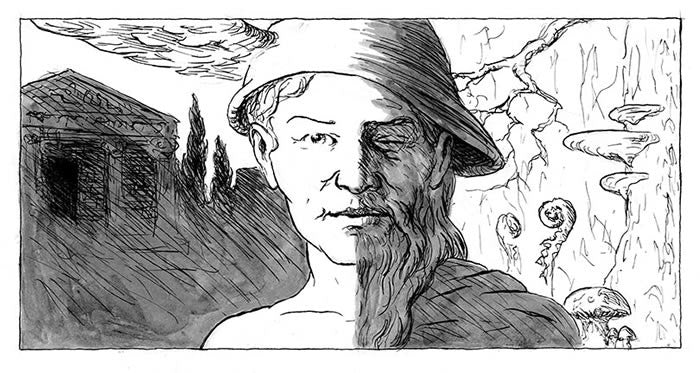
Many Americans have northern, central and western European blood: Norse, Germanic, British Isles, Celtic–and the latter two areas were invaded both by Germanic tribes and by the Norse, their relatives. If that’s your ethnic background or even a portion of it, then the characteristics of the ancient Norse god, Odin, may be just as relevant to you as the traits of the more Mediterrean classical Mercury. The Romans themselves associated Odin with Mercury rather than with Jupiter, their own chief god. In light of this article’s premise that the Hellenistic world’s concept of Mercury largely neglects the non-linear side of perception, and that the Norse Odin retains those right-brained, magical, hallucinatory and transformative elements, let’s explore some of Odin’s mythology.
Odin experienced two shamanic initiations. In one, he sacrificed one of his own eyes for the privilege of drinking from the Well guarded by the wise giant Mimir, in order to obtain awareness of the past–the name “Mimir” is related our word “memory”–and to acquire non- linear knowledge and intuition. His physical eyesight was partially sacrificed for another type of Sight or heightened awareness. Norse mythology has another Well, belonging to Urd, the first of the three Norse Fates, who rules the past. As Ralph Metzner states in his book The Well of Remembrance (Boston, MA: Shambala, 1994, p. 218), some critics believe that the two wells may have been versions of the same story. “Urd” means fate or destiny in old Norse, and Odin acquires knowledge of his essence, of the patterns that fate and destiny weave for gods and mortals alike, by drinking from this well.
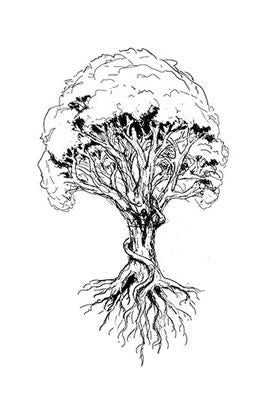 The second shamanic initiation and sacrifice occurred when Odin hung himself on the world axle-tree Yggdrasil that connects the nine worlds, in order to attain knowledge of the Runes. Human sacrifices to the Norse gods were often hung on trees. During this initiation, Odin makes a sacrificial offering of himself to himself, while in shamanic folklore, a tree often symbolizes a ladder to another world or state of consciousness. Used as the alphabet in some Norse countries until roughly as late as 1000 CE, the Runes were more than just letters. They were an oracle, and each symbol had a divinatory meaning. (For more on the Runes, a good place to start is Edred Thorsson’s Runelore: A Handbook of Esoteric Runology, New York: Weiser, 1987).
The second shamanic initiation and sacrifice occurred when Odin hung himself on the world axle-tree Yggdrasil that connects the nine worlds, in order to attain knowledge of the Runes. Human sacrifices to the Norse gods were often hung on trees. During this initiation, Odin makes a sacrificial offering of himself to himself, while in shamanic folklore, a tree often symbolizes a ladder to another world or state of consciousness. Used as the alphabet in some Norse countries until roughly as late as 1000 CE, the Runes were more than just letters. They were an oracle, and each symbol had a divinatory meaning. (For more on the Runes, a good place to start is Edred Thorsson’s Runelore: A Handbook of Esoteric Runology, New York: Weiser, 1987).
Classical Mercury and Norse Odin both rule writing–but the Runes were invested with the power and numinosity of Logos in the ancient Northern European world, and they were won with suffering. In both of these initiation tales, knowledge carries a price. As C.G. Jung wrote, “There is no coming to consciousness without pain.” Not the coming to this sort of non- ordinary consciousness. Here, Odin is a far cry from Hellenistic Mercury, who was more a bearer of other’s messages than a seeker after inner truth.
The search for wisdom took Odin down other difficult roads: the god was a psychopomp, a guide of souls. Here he shows a much closer parallel to classical Mercury, who escorted Persephone back from the underworld. Half of those who perish honorably in battle belong to Odin and travel to his hall after their death, while his ravens are traditionally birds of the dead. Yet Odin was also a necromancer, one who attains magical knowledge by conversing with the departed. When Odin’s son Baldur begins having nightmares about his own demise, Odin descends to the underworld to learn Baldur’s fate, where he raises the ghost of a sorceress to question her. He travels there on his eight-legged horse, which some scholars have seen as a symbolic coffin carried by four people. Odin also frequents hangings in order to communicate with the spirit of the victim on its way to the next world.
Death is, among other things, a transition from one state of awareness to another. Besides literal death of the physical body, we can also see these attributes of Odin as related to the self-knowledge that may spring from a psychological death: the death of a defense or a denial, or the ending of a certain phase or stage of your life. Such potentially transformative self-knowledge is seldom won without facing the underworld. Here, Odin is involved with profound psychological work, what we may call “soul retrieval.”
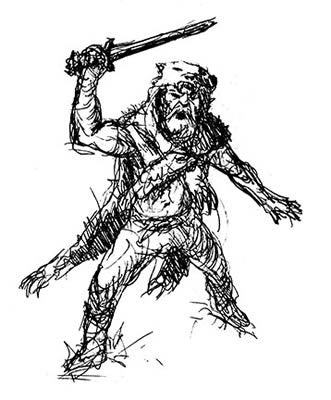 Both Odin and the fast-talking and light-fingered Mercury show elements of the Trickster archetype. The more famous Norse trickster, the fiery demigod Loki, is Odin’s foster brother, perhaps a kind of not fully acknowledged sibling–the sort of secretive brotherly rapport that might exist between two tricksters. Odin and Loki are both wily characters, shapeshifters; while among Odin’s many names are the Changing One, the Twofold One and the Hidden One. Not only is Odin’s appearance unpredictable as he wanders the mortal realm in various disguises, but his gifts are unreliable. Odin’s berserker frenzy may abandon a warrior in the midst of battle. Berserkers themselves were thought to be shapeshifters, a kind of were-bear–the name means “bear-shirt”–while other followers of Odin were hunters said to assume the form of a wolf. Besides ravens, wolves are Odin’s other animal ally–even his non-human form is elusive.
Both Odin and the fast-talking and light-fingered Mercury show elements of the Trickster archetype. The more famous Norse trickster, the fiery demigod Loki, is Odin’s foster brother, perhaps a kind of not fully acknowledged sibling–the sort of secretive brotherly rapport that might exist between two tricksters. Odin and Loki are both wily characters, shapeshifters; while among Odin’s many names are the Changing One, the Twofold One and the Hidden One. Not only is Odin’s appearance unpredictable as he wanders the mortal realm in various disguises, but his gifts are unreliable. Odin’s berserker frenzy may abandon a warrior in the midst of battle. Berserkers themselves were thought to be shapeshifters, a kind of were-bear–the name means “bear-shirt”–while other followers of Odin were hunters said to assume the form of a wolf. Besides ravens, wolves are Odin’s other animal ally–even his non-human form is elusive.
Doesn’t Mercury retrograde sometimes feel like the Trickster’s hand at work? The next time you’re wailing about what the latest transit of retrograde Mercury has wreaked in your nice orderly life, remember what Ralph Metzner says: that one function of the Trickster is to teach “by challenging our vanities and self-important preconceptions (The Well of Remembrance, p. 119.).” Again, the Odinic motif here is to attain a different level of awareness- -in this case, by having the rug pulled out from under you.
What could it mean to have Odin’s gifts unpredictably abandon you? Remember there are two ravens, Thought and Memory: reason and passion; sensation and intuition; logic and emotion; left brain and right brain. Perhaps if one raven is honored above the other, the overly emphasized raven may depart for a while.
For example, at the beginning of Charles Dickens’s A Christmas Carol, Scrooge is so firmly wedded to the raven of Reason and Sensation that when he first sees Marley’s ghost, he attributes it to indigestion. Reason abandons Scrooge for nearly the rest of the novel, as the raven of Intuition, in the form of the three ghosts of Christmas, shows him the error of his ways. This interpretation of Dickens is consistent with the Jungian premise about the importance of “holding the tension between the opposites” in a psychological polarity. Reason and intuition are opposite ends of the polarity of how one apprehends the environment–Mercury/Odin–and if one pole is overemphasized, it may “abandon” you, as the neglected pole suddenly erupts from your unconscious and temporarily takes over your perception system.
Odin, then, represents the modern Western world’s more neglected forms of perception: via the right brain, intuition, magic, non-ordinary states of awareness, the psychological underworld of the psyche and its transitional states, and the initiations by which one begins to explore this territory. Think of Odin as Mercury’s forgotten half, his shadow side, his mysterious partner, and your guide to non-Cartesian avenues of awareness. Let’s look at some interpretations of Odin-as-Mercury by sign.
ODIN IN ARIES:
Non-linear knowledge: is best attained quickly, in a breakthrough where the entire gestalt of a situation becomes apparent. You may need to quell anxiety about acquiring non- linear awareness, or impatience if it comes too slowly.
Initiation: can be a pivotal experience here, particularly in ways that test your mettle and require dealing with fears or taking initiative.
Transitions and “soul retrieval”: Don’t linger over finished situations. Acknowledge what was learned and move on as soon as resolution is complete.
The Trickster may challenge your: impatience, irritability, worry, aggression, competitiveness, recklessness or lack of consideration. You may listen too much to the raven of Passion.
ODIN IN TAURUS:
Non-linear knowledge: is attained through patient, persistent and methodical effort; and by practice rather than by didactic methods. It may come through the senses or while experiencing the natural world, and it could be a form of psychometry.
Initiation: may involve sensory deprivation, tests of physical endurance or discomfort, or situations where you must rely on your body’s instincts.
Transitions and “soul retrieval”: Accept them as part and parcel of the rhythms of the natural world.
The Trickster may challenge your: inclination to resist any changes even when they’re beneficial; stubbornness; literal-mindedness; attachment to creature comforts and the senses.
ODIN IN GEMINI:
Non-linear knowledge: is best achieved by radical alertness to all levels of stimuli and perception, no matter how irrational; by following the most fascinating paths available, and may involve telepathy.
Initiation: may involve enduring mental overload, having to be a beginner, or scenarios where the intellect won’t help.
Transitions and “soul retrieval”: Strive to listen to all parts of yourself, even the ones that don’t make as much sense as you’d like. Look for what can be learned from each change.
The Trickster may challenge your: proclivity to being easily bored or distracted, to intellectualize or rationalize, and not to follow through. Be mindful not to overglorify the raven of Thought.
ODIN IN CANCER:
Non-linear knowledge: occurs through willingness to explore the inner world of emotions, and may occur in images or feelings: clairvoyance, clairsentience, clairaudience.
Initiation: may include being overwhelmed by feelings; situations that feel emotionally dangerous or where your subjectivity is of no aid.
Transitions and “soul retrieval”: Learn both to let go of situations that are finished, and to use images from the unconscious–dreams, active imagination, creative efforts–to “midwife” the change.
The Trickster may challenge your: tendencies to moodiness, hypersensitivity, clinginess or self-centeredness. The raven of Emotion may be too honored here, polarizing you into situations where Reason has to find the way.
ODIN IN LEO:
Non-linear knowledge: is attained through openness, generosity, playfulness and creativity. Here we see the fairy-tale hero helping an old woman who’s a benevolent sorceress in disguise, and who grants him a gift.
Initiation: could include having to perform, to use extraversion and charisma, to call attention to yourself by sharing something from your core, to be in a leadership role–or, by the law of polarities, just the opposite.
Transitions and “soul retrieval”: Make artwork or a ritual to mark them, preferably with witnesses. Look for what there is to celebrate in any change, as well as what there is to grieve.
The Trickster may challenge your: inclinations to demand attention inappropriately, to be proud, egotistical, overbearing, melodramatic or too self-confident.
ODIN IN VIRGO:
Non-linear knowledge: is acquired by order and method, willingness to use one’s gifts both for personal growth and for service, and may involve telepathy.
Initiation: may mean making a profound commitment to your self-esteem, facing your fears of inadequacy and chaos, or giving up your need for the perfect.
Transitions and “soul retrieval”: Recognize that they don’t necessarily mean failure and can’t always be completely planned for in advance.
The Trickster may challenge your: tendency to overwork, get bogged down in detail, nitpick or be hypercritical of yourself and others. Take care not to pay too much heed to the raven of Reason.
ODIN IN LIBRA:
Non-linear knowledge: is gathered by your ability to relate fairly, with reciprocity and impartiality, to see others wholly as they are, and to remain calm and in balance. It may arrive via perceptions about other people.
Initiation: may involve radical trust in and cooperation with another person, including the active resolution of conflicts–or, conversely, having to work through something completely alone.
Transitions and “soul retrieval”: Learn to recognize that every extreme in the psyche travels hand in hand with its opposite, and that almost any change produces some anxiety.
The Trickster may challenge your: inconsistencies, indecisiveness, tendency to avoid even necessary conflict, and need for approval. Strive to maintain balance between the ravens of Reason and Passion.
ODIN IN SCORPIO:
Non-linear knowledge: is attained by your willingness to venture into the unknown and probe what’s hidden or taboo, to risk radical honesty, to seek catharsis, to go where the intensity is.
Initiation: could include facing your own dark side; having to trust your gut instincts; or facing your worst fears, perhaps about yourself, perhaps about the other side of the Veil.
Transitions and “soul retrieval”: Use them as a yardstick to measure the time left to you–are you using that time to live the life that’s most meaningful to you?
The Trickster may challenge your: moodiness; tendency to brood over a situation that’s beyond hope of further resolution; propensity to dramatize, obsess, or blow events out of proportion. Make every effort to form a better relationship with the raven of Reason.
ODIN IN SAGITTARIUS:
Non-linear knowledge: is acquired by your open-mindedness, tolerance, willingness to experience the new and exotic, commitment to maintain the widest perspective possible, and to live in accordance with the highest truths you know.
Initiation: may involve coping with an utterly alien environment or mindset, dealing with people whose moral or cultural premises you can’t comprehend or find abhorrent, or being restricted and confined.
Transitions and “soul retrieval”: Seek as many different perspectives on them as possible, but accept that life holds some mysteries–not all of them pleasant–that can’t be explained or understood.
The Trickster may challenge your: fear of meaninglessness and negativity, your self- righteousness, opinionatedness, self-aggrandizement, or unrealistic desire to keep all your options open forever. You know the raven of Intuition quite well–become better acquainted with the raven of Sensation.
ODIN IN CAPRICORN:
Non-linear knowledge: comes by patient, efficient, self-disciplined and consistent effort to attain concrete goals, and is connected with the ability to manifest something of your inner vision on the material plane, while conserving your integrity.
Initiation: may include learning to act strategically, with total self-reliance and excellent reality-testing; assuming responsibilities; choosing the right goal; or, conversely, learning to delegate.
Transitions and “soul retrieval”: Think about what behaviors you can initiate or alter to help ground a change in your daily life. Allow yourself to grieve, if appropriate, and don’t conceal feelings that should be shared.
The Trickster may challenge your: control issues, bossiness, inability to relax, pessimism, tendency to react with automatic negativity, and difficulty showing emotions. Become more comfortable with the raven of Passion.
ODIN IN AQUARIUS:
Non-linear knowledge: is best attained when you’re being authentically yourself, breaking the rules, being innovative, and striving for independence of mind, heart, will and spirit. It may come in unexpected flashes of insight where you connect seemingly unrelated data.
Initiation: could involve challenging authority; and/or having to leave your own “tribe” and thereby face your fears–ancient ones rooted in the collective unconscious–of isolation, ostracism or persecution.
Transitions and “soul retrieval”: Make sure you’re experiencing your own genuine reaction to a change, not the one that the status quo dictates you should have. Reflect on how the change could help you become more free.
The Trickster may challenge your: failure to declare independence in the right areas– which could lead to gratuitous eccentricities and symbolic rebellion–or your contrariness, reluctance to compromise, detachment, irresponsibility, or avoidance of intimacy.
ODIN IN PISCES:
Non-linear knowledge: can be attained by meditative, altered-state or visionary techniques, by acknowledging your own particular brand of sensitivity and exploring rather than numbing it, by dreams, creative play or intuitions.
Initiation: May involve a prolonged altered-state experience or, conversely, facing your addictive or escapist tendencies and having to deal with reality.
Transitions and “soul retrieval”: Remember that you’re living in two worlds at once: the one described on the evening news, and the spiritual dimensions of existence. Changes need to be worked through on both levels, not just one or the other.
The Trickster may challenge your: tendencies towards escapism, addictive or avoidance behavior, impracticality, poor reality-testing, absent-mindedness, chronic lateness, self-pity or martyrdom.
Much gratitude to Aubrey Brown for his illustrations. Visit his website: Aubrey Brown
To contact the astrologer and writer Jodie Forrest, please email her at jodietighe@gmail.com.
CAN’T GET ENOUGH NORSE MYTHOLOGY?
Check out these other resources on our site:
 Jodie Forrest's Nordic-Celtic historical fantasy trilogy --The Rhymer and the Ravens: The Book of Fate; The Elves' Prophecy: The Book of Being; and The Bridge: The Book of Necessity. The novels unfold in Nordic-Celtic ninth century Europe during the Viking Age, and in the mythic realms that parallel it: Elfland and Asgard. For more information about the philosophical framework of the world of these novels, see Dag Rossman's article, Ancient Nordic Spirituality, and our site's page about The Norse Runes.
Jodie Forrest's Nordic-Celtic historical fantasy trilogy --The Rhymer and the Ravens: The Book of Fate; The Elves' Prophecy: The Book of Being; and The Bridge: The Book of Necessity. The novels unfold in Nordic-Celtic ninth century Europe during the Viking Age, and in the mythic realms that parallel it: Elfland and Asgard. For more information about the philosophical framework of the world of these novels, see Dag Rossman's article, Ancient Nordic Spirituality, and our site's page about The Norse Runes.
Also see Jodie's articles on Odin As Mercury, and Astrological Mars and the Norse God Tyr; and download Jodie's recorded lectures Freya As Venus and Odin As Mercury.

